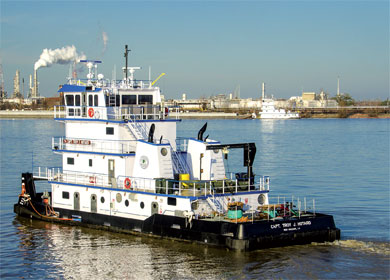Capt. Troy J. Hotard, a 90-foot, 3,000-hp towboat built by Eastern Shipbuilding for Florida Marine Transporters (FMT), represents a new chapter in a long-running story.
The boat, which went into service in early February, is the 56th 90-footer of the same basic design built for FMT by Eastern. The first was delivered in 2006. FMT has described this series of boats as “the largest single towboat build contract in history.”
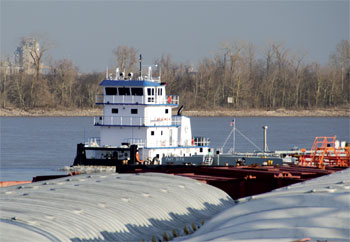 |
|
Originally designed for smaller waterways, the boats can operate on big rivers like the Mississippi. |
Yet Hotard, named after one of the company’s port captains, also represents the continuing evolution of this tried-and-true design. It is the first of the 90-footers to be powered by twin 1,500-hp Tier 3 engines. And it benefits from a hull that was redesigned a few years back, when FMT decided to move to more powerful engines.
The original 25 boats were powered by twin 1,200-hp engines, for a total output of 2,400 hp. Then FMT boosted the power to 2,600 hp. When Eastern was building hull No. 40 in early 2010, FMT realized that the 1,300-hp Caterpillar engines it had been using would no longer be available as the engine maker updated its lineup to conform to changing emission control standards.
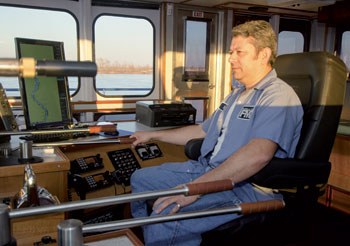 |
|
Capt. Mario Zepeda in the wheelhouse. |
The new Cat 3512 engines coming onto the market would have higher power ratings. Jeff Brumfield, FMT’s senior manager of boat construction, understood that before the company could install the more powerful Cat engines in his 90-footers, some design changes would have to be made.
Instead of operating at 1,200 rpm, the new engines would be running at 1,600 rpm. That would require a change in the gearbox ratio to 6.04, up from 5.04, as well as a revision in the size and pitch of the propellers. But most importantly, the hull form would have to be tweaked.
“We needed to change the hull form to use that horsepower,” he said. “We knew we’d end up at 3,000…. We were handling 2,600 fine. We knew we were at the edge of the envelope.”
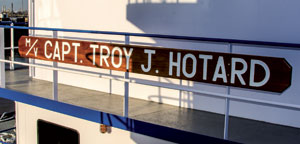 |
|
The new boat was named after one of Florida Marine’s port captains. |
An increase in power, he explained, can induce turbulence and cavitation. “There are all sorts of issues if the hull isn’t ready for the power. If you’re right on the edge of the envelope, a couple hundred RPMs induces things you don’t want.”
However, FMT did not want to radically alter the design of a boat that had proven to be such a reliable workhorse. The solution was to redesign just the stern. The job was given to Gilbert Associates Inc., a naval architecture and marine engineering firm based in Hingham, Mass.
Over the life of the long contract, Eastern Shipbuilding has figured out how to build the boats efficiently, so Gilbert Associates was told to accomplish its goals with a minimum of changes to the hull.
“We worked within the confines of the existing structure,” said John W. Gilbert, president of Gilbert Associates. “We weren’t allowed to go too far forward.”
The primary change was to increase the size of the “tunnels,” the indentations in the hull that aid the flow of water to the props.
The tunnels had to be enlarged to accommodate the larger horsepower and propellers in the newer boats and to improve the flow of water to the props.
The new design also addressed the separation of flanking rudder positions due to the larger propellers and tunnels.
The original tunnels “wouldn’t have allowed a larger propeller to turn in that tunnel,” Gilbert said.
“You’re trying to open them (tunnels) up as much as you can. You don’t want to starve the propellers of water,” Gilbert said.
The more powerful engines and larger propellers also created potential vibration problems, compounded by the fact that the boats often operate in shallow water, where the forces created by turbulence can be transferred to the hull.
“The boat can undergo tremendous amounts of stress,” Gilbert said, strong enough to cause structural damage. And the vibrations can also mean higher noise and stress levels for the crew. By allowing the boats to make efficient use of the larger engines, the design changes also contributed to crew comfort.
“All river towboats suffer some amount of vibratory loads presented from bottom influence, especially in very shallow depths,” Gilbert said. “Proper structural continuity, tunnel form for water flow and other design measures to appendages are made to reduce the vibrations as much as possible.”
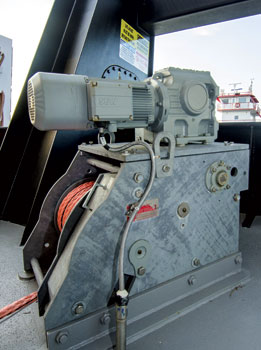 |
|
One of two Patterson 40-ton electric deck winches on the bow. |
In addition to smoothing out the stern for better flow to the props, Brumfield said the changes included increasing the size of the steering and flanking rudders. The net effect has been to increase the towing capacity and efficiency of the newest boats.
The new hull form was used in the construction of hull No. 46, which was still a 2,600-hp boat. The first 2,800-hp boat was hull No. 51. It went into service in 2012.
That’s when the changes really began to pay benefits.
FMT calls these boats its Canal class. Originally they were designed to operate on an east-west route in the Gulf Intracoastal Waterway, with up to three or four 30,000-barrel barges, typically carrying liquid petroleum and chemical products. The small, maneuverable boats proved to be ideal for shallow, winding routes like the ICW and the Tennessee-Tombigbee Waterway, which Brumfield described as “like a snake — the curves are sharp and they’re many.”
In time, however, FMT discovered that its 90-footers could also hold their own on the Mississippi and Ohio rivers. “We found they do just fine on the river,” Brumfield said. Given their size, there are limits to how many barges they can handle, compared with bigger boats built for the Mississippi.
Looking up at his operations map in his office, he observed that of the 56 90-footers in the fleet, at least 10 were operating on the Mississippi on that day, while the remaining boats were operating east-west.
The arrival of the new generation of more powerful boats brings with it the potential for expanding operations on the Mississippi and Ohio rivers.
“With 3,000 hp, in certain river conditions, you might be able to gain an entire barge additional,” Brumfield said. That would mean a substantial increase in the earning potential of the new boats.
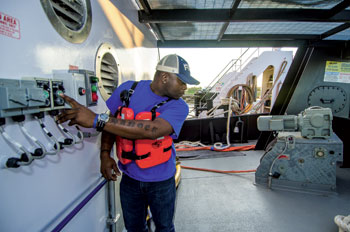 |
|
Deck hand Jonathan Sanders operating one of the winches. |
While the power and efficiency of the boat are at the heart of the redesign, the comfort and efficiency of the crew remain as key design goals.
“These are comfortable boats,” said Stephen J. Berthold, Eastern Shipbuilding’s vice president of sales and marketing. “You get crew comfort, you get crew retention.”
Berthold said the boats were also notable for the amount of the latest technology that had been incorporated into them. “These boats are pretty sophisticated for what they are,” he said. “They’ve got a lot of technology on those boats,” including a Rose Point electronic chart and navigation system.
Brumfield also emphasized the importance of crew comfort. The crews generally work a schedule of 28 days on and 14 days off, and some crewmembers work even longer in order to earn more money. Given the amount of time the crews spend on the boats, it is imperative to make them as livable as possible, he said. “Today you have to make them nice and comfortable.”
One of the features that he is particularly proud of is the ductless air conditioning system that serves the pilothouse. “Some other people are starting to do this, but I may have been one of the very first.”
The system has two separate 3.5-ton units, giving it 100 percent redundancy, since either unit can handle a normal cooling load by itself. The cooling units, which are located outside the house, pump coolant to a heat exchanger in the pilothouse, where fans circulate the cool air.
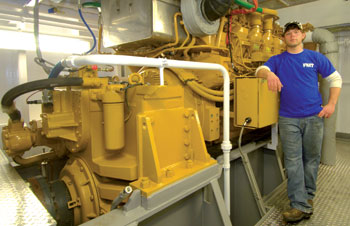 |
|
Deck hand Ryan Breaux with one of the two Caterpillar 3512C main engines, which generate 1,500 hp each at 1,600 rpm. These bigger engines in Florida Marine’s newer boats required a redesign of their sterns to allow them to fully exploit the additional power. |
Because ductwork can be difficult to run, ducted systems tend to be undersized and may strain to provide adequate cooling, Brumfield said. The ductless system on his boats should ensure that the temperatures in the pilothouse remain at comfortable levels in even the hottest conditions.
Other than the pilothouse, the other spaces on the boat have conventional air conditioning.
The boats carry a crew of six: captain, pilot, two deck hands and two tankermen. The quarters include four single-bunk rooms and one double.
The vessels have wireless Internet. The galley features granite countertops, stainless appliances and custom-built cabinetry made of solid wood.
“We make these boats as nice as we logically can,” and use the best materials available, Brumfield said.
While elements of the design have gradually evolved, FMT has tried to keep the essence of the boats unchanged. That makes it easier for the crew to move from one to the other. When they arrive on a new boat, the basic layout remains familiar.
“That definitely increases safety,” Brumfield said. “The different boats all look the same to them.”
The similarity of the boats in the fleet makes maintenance simpler as well. The inventory of spare parts is much less complicated than it would be for a fleet with many kinds of boats. And when a problem does arise, vendors know how to help. “They’re familiar with the boats; they know what you’re talking about,” Brumfield said.
So after a building program that has continued for almost a decade, FMT still likes what it sees coming out of Eastern Shipbuilding: durable boats that are efficient, safe and comfortable.

